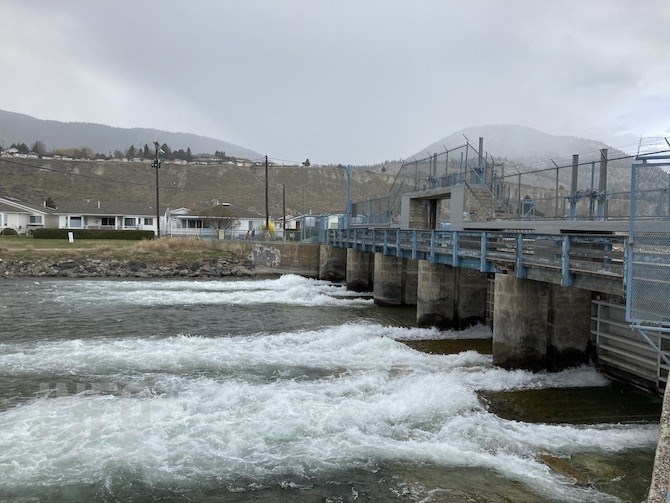
FILE PHOTO - Water is seen flowing through the Okanagan Lake dam in the South Okanagan, April 8, 2021.
(STEVE ARSTAD / iNFOnews.ca)
August 23, 2021 - 12:51 PM
The B.C. Wildlife Federation says the 28-year effort to restore kokanee populations in Okanagan Lake is being undermined by the lowering of the lake’s water level this year.
The province began drawing down Okanagan Lake in February to mitigate flood risks, but in early March government biologists and First Nations partners became concerned it was exposing shoreline spawning areas, stranding unhatched kokanee eggs and immature fry, according to Freedom of Information documents obtained by the non-profit group.
Sampling in the field showed kokanee fry were not as mature as anticipated, they could not swim freely and “therefore significant numbers would be stranded by further lake level drops,” according to the documents.
An excavation of shoreline gravel led by a government biologist found mainly dead eggs in the 25 centimetre vertical drawdown zone, according to the documents.
A summary report by a senior fisheries biologist Tara White noted in a media release issued today, Aug. 23, 75% of the kokanee eggs and fry in the survey area were dead. The report speculated the late winter drawdown of Okanagan Lake had a direct impact on kokanee shore spawning egg development and survival and the scale of the impact is unclear.
“Since the Okanagan Lake kokanee population crash of the mid-1990s, First Nations, local conservation groups and regional fisheries staff have spent millions of dollars and countless volunteer hours in a concerted effort to rebuild these important fish. By drying these eggs up we may have just set ourselves back decades,” said Patrick Whittingham, Okanagan region president for the B.C. Wildlife Federation, in a the release.
“The problem is the government’s inflow water modelling tools are not able to keep up with the effects of climate change on runoff and the lake itself,” Jesse Zeman, director of fish and wildlife restoration with the non-profit, said in the release.
Holding the water level high in the spring increases the risk of flooding, because the water release infrastructure can't manage water levels on a day-to-day basis, Zeman said. A large release of water downstream of Penticton can also negatively impact sockeye fry which emerge in the Okanagan River.
The Penticton Dam can only lower the lake’s level by about one and three quarter centimetres per day and with climate change spring runoff can raise the lake’s level as many as seven to eight centimeters, he said.
“The interim solution for the kokanee is to draw down the lake before October, so that spawners lay their eggs further down the shoreline,” Zeman said.
“In the short-term, B.C. needs a watershed security fund and strategy to deal with the earlier and more intense spring runoff followed by the dry summers we’re currently experiencing. In the long term Okanagan valley homes and buildings are going to have to be built or moved further from the lake and stream edges so that these unprecedented runoff and drought cycles do not continue to flood people’s property," he said.
The Ministry of Forests, Lands and Natural Resource Operations did not immediately return a request for comment.
To contact a reporter for this story, email Carli Berry or call 250-864-7494 or email the editor. You can also submit photos, videos or news tips to the newsroom and be entered to win a monthly prize draw.
We welcome your comments and opinions on our stories but play nice. We won't censor or delete comments unless they contain off-topic statements or links, unnecessary vulgarity, false facts, spam or obviously fake profiles. If you have any concerns about what you see in comments, email the editor in the link above.
News from © iNFOnews, 2021